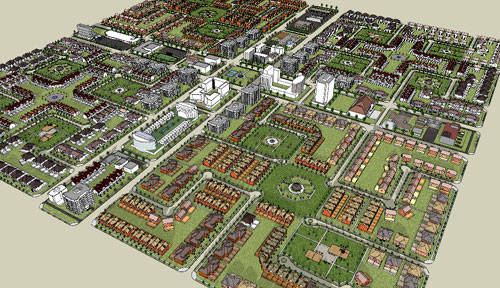The Fused Grid: A Balanced Approach to Development
A contemporary street pattern that responds to environmental and quality of life issues
1. Definition
The Fused Grid is a neighbourhood and district layout model. It combines the geometries of inner city grids and of the conventional suburbs. This fusion results in retaining the best characteristics of each and none of their disadvantages while raising the quality of the neighbourhood environment.
2. The problem
Street patterns affect the environment and neighbourhood quality of life:
Environment - street patterns consume land (up to 35% of a district) and resources for their emplacement and maintenance (up to 20% of municipal infrastructure budget). Streets incorporate a dwindling resource (bitumen). Local streets represent the bulk of the entire network mileage of a region (over 70%). They add to the impermeable surface area with a negative impact on water quality and contribute to urban heat that affects cooling energy demand. Street patterns can impede or enable walking and bicycling thereby influencing energy use for transport. They can restrict or accommodate the flow of traffic thereby affecting GHG generation.

A Fused Grid district with four quandrants and a mixed use zone.(click to enlarge)
Quality of life - street patterns can reduce or increase the risk of fatal accidents or injuries to people, particularly to children and seniors (walking is currently the least safe mode of travel). They can help increase the level of tranquility in a neighbourhood and support social networking, which in turn reinforces a sense of security. They can reduce the noise intrusion and improve local air quality by managing traffic. They can make walking and biking pleasant or undesirable thus favoring or discouraging an active lifestyle. Street patterns can support or undermine the viability of amenities required for daily routines by providing or denying convenient access to them.
The problem in a nutshell: Conventional subdivision street patterns inhibit walking and are disorienting and confusing to pedestrians as well as to drivers. They provide tranquility, safety and security at the expense of connectivity. They manage traffic well but often create bottlenecks at peak times in predictable spots.
Conversely, centre-city street grid patterns, the inheritance of a strictly pedestrian era, provide connectivity but at the expense of tranquility, safety and security. These patterns ushered the era of traffic calming in response to their inherent flaws. Without intensive management they often cause traffic gridlock which intensifies GHG emissions, air impurity, noise and driver frustration. They are the most land consumptive and consequently the least environmentally sustainable
3. The opportunity
Street patterns that respond to current environmental concerns and to the constant quest for quality of life offer a unique opportunity to lead the development industry with a solution that is financially and environmentally sound.
Each of the existing street patterns has positive attributes yet neither satisfies the entire set of environmental and quality of life criteria. The answer lies in their combination which is embodied in the Fused Grid. It uses a continuous grid of roads for district and regional connectivity and a discontinuous grid of streets for neighbourhood safety. The latter grid is supplemented by footpaths that connect all streets turning a neighbourhood into a fully connected pedestrian realm. This combination of continuous and discontinuous street grids:
- Optimizes the use of land for streets
- Secures tranquil and safe neighbourhoods
- Increases the potential for social interaction
- Reduces the amount of impermeable surfaces
- Optimizes infrastructure
- Assists district and regional traffic flow
- Encourages walking while positively discouraging short-distance driving
- Provides opportunities for rain water management
In addition, the fused grid, anticipates and channels land intensification and mixed uses by creating a zone with high potential for change. It can also accommodate adaptations to future traffic demand.
In summary the fused grid balances the need of the pedestrian and the motorist. It responds to the quest for economic efficiency and to the need for environmental stewardship.
